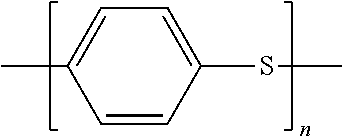A fiber-grade polyphenylene sulfide resin synthesis method
a polyphenylene sulfide resin and fiber-grade technology, applied in the field of polyphenylene sulfide resin synthesis method, can solve the problems of one real industrialized method, poor impact resistance of products produced with such method, and relatively poor humidity resistance,
- Summary
- Abstract
- Description
- Claims
- Application Information
AI Technical Summary
Benefits of technology
Problems solved by technology
Method used
Image
Examples
embodiment 1
[0044]29.74 Kg (300.0 mol) N-methyl-2-pyrrolidone (hereinafter referred to as NMP), 13.0 Kg (130.0 mol) 40% sodium hydroxide and 3.485 Kg (30.0 mol) hexanoic acid were added into a 100 L reactor for heating to the temperature of 120° C. at the velocity of 2.0° C. / min simultaneously with mixing at the velocity of 300 rpm and nitrogen protection. Heat preservation was conducted for 1 hour prior to further heating to the temperature of 200° C. at the velocity of 2.0° C. / min. 8.74 Kg aqueous solution (97.88% water content) was eliminated prior to cooling to the temperature of 130° C. 14.02 Kg (100.0 mol) 40% sodium bisulfide and 4.09 Kg (41.3 mol) NMP were added for heating to the temperature of 200° C. at the velocity of 1.5° C. / min while maintaining same mixing velocity. 9.71 Kg aqueous solution (86.59% water content) was eliminated prior to cooling to the temperature of 160′C. At this point, sulfur and water content in the system were 99.0 mol and 87.8 mol, respectively.
[0045]14.55 K...
embodiment 2
[0048]29.74 Kg (300.0 mol) N-methyl-2-pyrrolidone (hereinafter referred to as NMP), 11.56 Kg (130.0 mol) 45% sodium hydroxide and 3.485 Kg (30.0 mol) 2-ethyl butyric acid were added into a 100 L reactor for heating to the temperature of 90° C. at the velocity of 1.0° C. / min simultaneously with mixing at the velocity of 100 rpm and nitrogen protection. Heat preservation was conducted for 3 hours prior to further heating to the temperature of 180° C. at the velocity of 1.0° C. / min. 7.12 Kg aqueous solution (97.23% water content) was eliminated prior to cooling to the temperature of 110° C. 14.02 Kg (100.0 mol) 40% sodium bisulfide and 4.09 Kg (41.3 mol) NMP were added for heating to the temperature of 180° C. at the velocity of 0.7° C. / min while maintaining same mixing velocity. 9.58 Kg aqueous solution (87.81% water content) was eliminated prior to cooling to the temperature of 140° C. At this point, sulfur and water content in the system were 99.1 mol and 98.8 mol, respectively.
[004...
embodiment 3
[0052]27.76 Kg (280.0 mol) N-methyl-2-pyrrolidone (hereinafter referred to as NMP), 11.0 Kg (110.0 mol) 40% sodium hydroxide and 1.021 Kg (10.0 mol) pentanoic acid were added into 100 L reactor for heating to the temperature of 100° C. at the velocity of 1.5° C. / min simultaneously with mixing at the velocity of 200 rpm and nitrogen protection. Heat preservation was conducted for 2 hours prior to further heating to the temperature of 190° C. at the velocity of 1.5° C. / min. 7.03 Kg aqueous solution (97.52% water content) was eliminated prior to cooling to the temperature of 110° C. 18.69 Kg (100.0 mol) 30% sodium bisulfide and 5.69 Kg (57.5 mol) NMP were added for heating to the temperature of 190° C. at the velocity of 1.5° C. / min while maintaining same mixing velocity. 14.88 Kg aqueous solution (87.95% water content) was eliminated prior to cooling to the temperature of 150° C. At this point, sulfur and water content in the system were 99.0 mol and 96.3 mol, respectively.
[0053]148.4...
PUM
| Property | Measurement | Unit |
|---|---|---|
| temperature | aaaaa | aaaaa |
| temperature | aaaaa | aaaaa |
| temperature | aaaaa | aaaaa |
Abstract
Description
Claims
Application Information
 Login to View More
Login to View More - R&D
- Intellectual Property
- Life Sciences
- Materials
- Tech Scout
- Unparalleled Data Quality
- Higher Quality Content
- 60% Fewer Hallucinations
Browse by: Latest US Patents, China's latest patents, Technical Efficacy Thesaurus, Application Domain, Technology Topic, Popular Technical Reports.
© 2025 PatSnap. All rights reserved.Legal|Privacy policy|Modern Slavery Act Transparency Statement|Sitemap|About US| Contact US: help@patsnap.com

